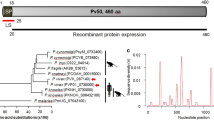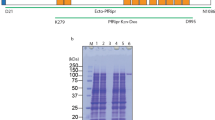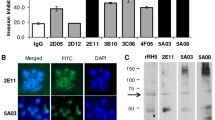Abstract
Monoclonal antibody M26-32 has been shown to strongly inhibit the growth of Plasmodium falciparum in vitro. To identify the target antigen of M26-32, a P. falciparum Dd2 asexual stage cDNA expression library was screened with this antibody, and a full open reading frame cDNA was obtained. This gene, named pfmag-1, encodes a polypeptide of 589 amino acids. The protein PfMAg-1 was characterized as a membrane-associated protein that expressed on the surface of merozoite during erythrocytic stage. Remarkably, at the C terminus of PfMAg-1, there are 14 copies of a deca-peptide sequence of QTDEIKND (H/N) I. This tandem repeat domain was identified to harbor the epitope of the protective M26-32 monoclonal antibody, and was also recognized by sera of patients infected with P. falciparum. Rabbit antibody elicited against this deca-peptide repeat domain effectively inhibited P. falciparum invasion in vitro. Our work suggests that PfMAg-1 is a promising malaria vaccine candidate.








Similar content being viewed by others
References
Abbas AK, Lichtman AH, Pillai S (2007) Recognition of antigens. In: Schmitt W (ed) Cellular and molecular immunology, 6th edn. Saunders Elsevier, Philadelphia, pp 75–149
Amit AG, Mariuzza RA, Phillips SE, Poljak RJ (1986) Three-dimensional structure of an antigen–antibody complex at 2.8 A resolution. Science 233:747–753
Baumeister S, Endermann T, Charpian S, Nyalwidhe J, Duranton C, Huber S, Kirk K, Lang F, Lingelbach K (2003) A biotin derivative blocks parasite induced novel permeation pathways in Plasmodium falciparum-infected erythrocytes. Mol Biochem Parasitol 132:35–45
Berzins K (2002) Merozoite antigens involved in invasion. Chem Immunol 80:125–143
Blackman MJ, Heidrich HG, Donachie S, McBride JS, Holder AA (1990) A single fragment of a malaria merozoite surface protein remains on the parasite during red cell invasion and is the target of invasion-inhibiting antibodies. J Exp Med 172:379–382
Bouharoun-Tayoun H, Druilhe P (1992) Plasmodium falciparum malaria: evidence for an isotype imbalance which may be responsible for delayed acquisition of protective immunity. Infect Immun 60:1473–1481
Bouharoun-Tayoun H, Attanath P, Sabchareon A, Chongsuphajaisiddhi T, Druilhe P (1990) Antibodies that protect humans against Plasmodium falciparum blood stages do not on their own inhibit parasite growth and invasion in vitro, but act in cooperation with monocytes. J Exp Med 172:1633–1641
Bouharoun-Tayoun H, Oeuvray C, Lunel F, Druilhe P (1995) Mechanisms underlying the monocyte-mediated antibody-dependent killing of Plasmodium falciparum asexual blood stages. J Exp Med 182:409–418
Burns JM Jr, Adeeku EK, Dunn PD (1999) Protective immunization with a novel membrane protein of Plasmodium yoelii-infected erythrocytes. Infect Immun 67:675–680
Cheng Q, Jones G, Liu EX, Kidson C, Saul A (1991) Identification of a common Plasmodium epitope (CPE) recognised by a pan-specific inhibitory monoclonal antibody. Mol Biochem Parasitol 49:73–82
Cohen S, Mc GI, Carrington S (1961) Gamma-globulin and acquired immunity to human malaria. Nature 192:733–737
Dessens JT, Beetsma AL, Dimopoulos G, Wengelnik K, Crisanti A, Kafatos FC, Sinden RE (1999) CTRP is essential for mosquito infection by malaria ookinetes. EMBO J 18:6221–6227
Egan AF, Burghaus P, Druilhe P, Holder AA, Riley EM (1999) Human antibodies to the 19 kDa C-terminal fragment of Plasmodium falciparum merozoite surface protein 1 inhibit parasite growth in vitro. Parasite Immunol 21:133–139
Florens L, Liu X, Wang Y, Yang S, Schwartz O, Peglar M, Carucci DJ, Yates JR 3rd, Wub Y (2004) Proteomics approach reveals novel proteins on the surface of malaria-infected erythrocytes. Mol Biochem Parasitol 135:1–11
Foley M, Tilley L, Sawyer WH, Anders RF (1991) The ring-infected erythrocyte surface antigen of Plasmodium falciparum associates with spectrin in the erythrocyte membrane. Mol Biochem Parasitol 46:137–147
Greenwood B, Mutabingwa T (2002) Malaria in 2002. Nature 415:670–672
Harlow E, Lane D (1988) Monoclonal antibodies and growing hybridomas. Antibodies: a laboratory manual. Cold Spring Harbor Laboratory Press, Cold Spring Harbor, pp 139–282
Holder AA, Lockyer MJ, Odink KG, Sandhu JS, Riveros-Moreno V, Nicholls SC, Hillman Y, Davey LS, Tizard ML, Schwarz RT et al (1985) Primary structure of the precursor to the three major surface antigens of Plasmodium falciparum merozoites. Nature 317:270–273
Kemp DJ, Coppel RL, Anders RF (1987) Repetitive proteins and genes of malaria. Annu Rev Microbiol 41:181–208
Lambros C, Vanderberg JP (1979) Synchronization of Plasmodium falciparum erythrocytic stages in culture. J Parasitol 65:418–420
Li WL, Liu EX, Fan RG, Mao YH (1984) Characterization of Plasmodium yoelii antigens by monoclonal antibodies, I. Common antigens between erythrocytic stages of Plasmodium yoelii and human malaria parasites. J Parasitol Parasit Dis 2:83–87
Li WL, Fan RG, Mao YH, Liu EX, Arriat D, da Silva LP (1986) Characterization of McAbs (M26-32, F6-C2 and F6-D3) against Plasmodium falciparum. Zhongguo Yi Xue Ke Xue Yuan Xue Bao 8:430–434
Li F, Templeton TJ, Popov V, Comer JE, Tsuboi T, Torii M, Vinetz JM (2004a) Plasmodium ookinete-secreted proteins secreted through a common micronemal pathway are targets of blocking malaria transmission. J Biol Chem 279:26635–26644
Li H, Han Z, Lu Y, Lin Y, Zhang L, Wu Y, Wang H (2004b) Isolation and functional characterization of a dynamin-like gene from Plasmodium falciparum. Biochem Biophys Res Commun 320:664–671
Lopez-Ribot JL, Alloush HM, Masten BJ, Chaffin WL (1996) Evidence for presence in the cell wall of Candida albicans of a protein related to the hsp70 family. Infect Immun 64:3333–3340
Marshall VM, Silva A, Foley M, Cranmer S, Wang L, McColl DJ, Kemp DJ, Coppel RL (1997) A second merozoite surface protein (MSP-4) of Plasmodium falciparum that contains an epidermal growth factor-like domain. Infect Immun 65:4460–4467
Matuschewski K, Nunes AC, Nussenzweig V, Menard R (2002) Plasmodium sporozoite invasion into insect and mammalian cells is directed by the same dual binding system. EMBO J 21:1597–1606
Ogura T, Wilkinson AJ (2001) AAA+ superfamily ATPases: common structure–diverse function. Genes Cells 6:575–597
Ramasamy R (1998) Molecular basis for evasion of host immunity and pathogenesis in malaria. Biochim Biophys Acta 1406:10–27
Ridley RG, Takacs B, Lahm HW, Delves CJ, Goman M, Certa U, Matile H, Woollett GR, Scaife JG (1990) Characterisation and sequence of a protective rhoptry antigen from Plasmodium falciparum. Mol Biochem Parasitol 41:125–134
Sachdeva S, Mohnvned A, Dasaradhi PV, Crabb BS, Katyal A, Malhotra P, Chauhan VS (2006) Immunogenicity and protective efficacy of Escherichia coli expressed Plasmodium falciparum merozoite surface protein-1(42) using human compatible adjuvants. Vaccine 24(12):2007–2016
Shi YP, Udhayakumar V, Oloo AJ, Nahlen BL, Lal AA (1999) Differential effect and interaction of monocytes, hyperimmune sera, and immunoglobulin G on the growth of asexual stage Plasmodium falciparum parasites. Am J Trop Med Hyg 60:135–141
Smythe JA, Coppel RL, Brown GV, Ramasamy R, Kemp DJ, Anders RF (1988) Identification of two integral membrane proteins of Plasmodium falciparum. Proc Natl Acad Sci USA 85:5195–5199
Smythe JA, Coppel RL, Day KP, Martin RK, Oduola AM, Kemp DJ, Anders RF (1991) Structural diversity in the Plasmodium falciparum merozoite surface antigen 2. Proc Natl Acad Sci USA 88:1751–1755
Snow RW, Guerra CA, Noor AM, Myint HY, Hay SI (2005) The global distribution of clinical episodes of Plasmodium falciparum malaria. Nature 434:214–217
Sultan AA, Thathy V, Frevert U, Robson KJ, Crisanti A, Nussenzweig V, Nussenzweig RS, Menard R (1997) TRAP is necessary for gliding motility and infectivity of Plasmodium sporozoites. Cell 90:511–522
Taylor RR, Smith DB, Robinson VJ, McBride JS, Riley EM (1995) Human antibody response to Plasmodium falciparum merozoite surface protein 2 is serogroup specific and predominantly of the immunoglobulin G3 subclass. Infect Immun 63:4382–4388
Trager W, Jensen JB (1976) Human malaria parasites in continuous culture. Science 193:673–675
Vale RD (2000) AAA proteins. Lords of the ring. J Cell Biol 150:F13–F19
Wahlgren M, Berzins K, Perlmann P, Bjorkman A (1983) Characterization of the humoral immune response in Plasmodium falciparum malaria. I. Estimation of antibodies to P. falciparum or human erythrocytes by means of microELISA. Clin Exp Immunol 54:127–134
Acknowledgments
We thank Professor Lina Wang for kindly providing anti-PfMSP-4 rabbit serum and recombinant protein PfMSP-119. We would also like to thank Professor QiJun Chen (Microbiology and Tumor Biology Center, Karolinska Institutet, the Swedish Institute for Infectious Disease Control, Sweden) for valuable advice to this work. This investigation was supported by grants from the National High Technology Research and Development Program (#102-07-04-02) and China Medical Board (CMB, New York, USA) (#98-674).
Author information
Authors and Affiliations
Corresponding author
Rights and permissions
About this article
Cite this article
Gao, YH., Li, HL., Lu, Y. et al. Identification of a vaccine candidate antigen, PfMAg-1, from Plasmodium falciparum with monoclonal antibody M26-32. Parasitol Res 105, 1723–1732 (2009). https://doi.org/10.1007/s00436-009-1617-4
Received:
Accepted:
Published:
Issue Date:
DOI: https://doi.org/10.1007/s00436-009-1617-4




